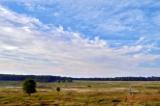 © Bruce McNitt/Panoramic Images (Virginia)
© Bruce McNitt/Panoramic Images (Virginia)

Virginia Natural Landscape Assessment
Background
One of the fundamental benefits of intact expanses of natural habitat pertains to the species-area relationship in which the richness of species increases progressively with habitat size. In general, biodiversity approximately doubles with every tenfold increase in habitat area. Large patches tend to have greater variety of habitats and more protection from disturbance from adjacent areas. Thus they tend to have higher numbers of species than small patches.
Certain species require cover deep within the interior of continuous habitat that is far away from natural or human-induced edges. These core areas, which for sensitive interior species may be many times the size of their home ranges, insulate species from edge effects that adversely affect their ability to survive and reproduce.
For forest dwelling birds, these edge effects include nest and adult predation by edge-inhabiting species such as raccoon, striped skunk, red fox, American Crow, and Blue Jay, which usually are not found in extensive forests with a high proportion of interior conditions. Where suburban development is juxtaposed with natural land, the domestic cat can be a significant source of predatory losses for birds and small mammals. Another edge effect causing significant declines in songbird populations is brood parasitism by Brown-headed Cowbirds, which lay their eggs in the nests of other species to be hatched and raised by the host. Because most forest dwelling bird species in eastern North America did not evolve with cowbirds, few eastern breeding host species have defenses against them.
There also are environmental edge effects that include differences in wind velocity, temperature, light, and relative humidity (Harris 1984). These environmental effects, which are most pronounced when the differences in adjacent land covers are greatest such as with a forest-lawn edge, can change habitats enough that they be become unsuitable.
Large patches also are important for their ecosystem services, including filtering nutrients and pollutants from water, preventing erosion, retaining soil, providing pollinators for crops, removing carbon from the air and sequestering it in woody biomass, slowing and absorbing runoff so groundwater is recharged, absorbing solar energy and keeping local areas cooler, and providing protection from storm and flood damage. Ecosystem services often are overlooked as landscapes are developed largely because traditional economic analyses that incorporate the financial benefits of development usually do not include the financial benefits of ecosystem services. Studies have estimated that these services contribute as much or more to the global economy as do marketplace processes (Costanza et al. 1997) and that they can result in a return on investment in excess of 100 to 1 when natural lands are conserved (Balmford et al. 2002). These financial benefits are further increased when considering the recreational opportunities natural lands provide and the tourism revenues they generate.
The Assessment
The Virginia Natural Heritage Program (VNHP) in the Department of Conservation and Recreation has developed a network of natural lands for the commonwealth of Virginia. This project, named the Virginia Natural Landscape Assessment (VaNLA), is a landscape-scale geospatial analysis for identifying, prioritizing, and linking natural lands in Virginia. Using land cover data derived from satellite imagery, the VaNLA identifies large patches of natural land with at least one hundred acres of interior cover. This interior cover, known as core area, begins one hundred meters from patch edges. Small patches with ten to ninety-nine acres of interior cover are included as habitat fragments that support landscape corridors and that may be important in localities with few large patches of natural land. For simplicity in the remainder of this document, core areas and habitat fragments will be referred to collectively as ecological cores. Although the VaNLA is predominantly an analysis of forests, ecological cores include marshes, dunes, and beaches where these covers are abundant and exceed minimum size requirements.
Ecological cores were mapped for the entire study area, which included the commonwealth of Virginia and a 20-mile buffer around the state. Over fifty attributes were assigned to the ecological cores providing information about rare species and habitats, environmental diversity, species diversity, patch characteristics, patch context, and water quality benefits. These attributes can be used by planners to select ecological cores that have the characteristics and provide the benefits of greatest interest to them. To assist in identifying highly significant ecological cores, VNHP selected nine ecological attributes and used them in a principal components analysis to develop a prioritization by ecological integrity. The following paragraph provides a synopsis of ecological integrity and describes the factors used in the prioritization.
Maintaining vital natural landscapes is essential for basic ecosystem services such as cleaning our air and filtering our water. Natural lands also harbor thousands of species of animals and plants and contain libraries of genetic information from which we derive new foods, materials, and medicinal compounds. These parts of the landscape also provide us with recreational opportunities and open space resources. But these qualities are represented differently across the cores and habitat fragments that constitute the natural landscape. To assess their unique values, each core and habitat fragment has been assigned an Ecological Integrity Score that rates the relative contribution of that area to the ecosystem service values above. In general, larger, more biologically diverse areas are given higher scores. Scores are enhanced if the core or habitat fragment is part of a larger complex of natural lands. Scores also are increased for those cores and habitat fragments that contribute to water quality enhancement.
The resulting scores were classified into five categories of ecological integrity: C1 – Outstanding; C2 – Very High; C3 – High; C4 – Moderate; and C5 – General.
Read more about assessment and how the VaNLA is being used to make conservation happen in Virginia, here.






